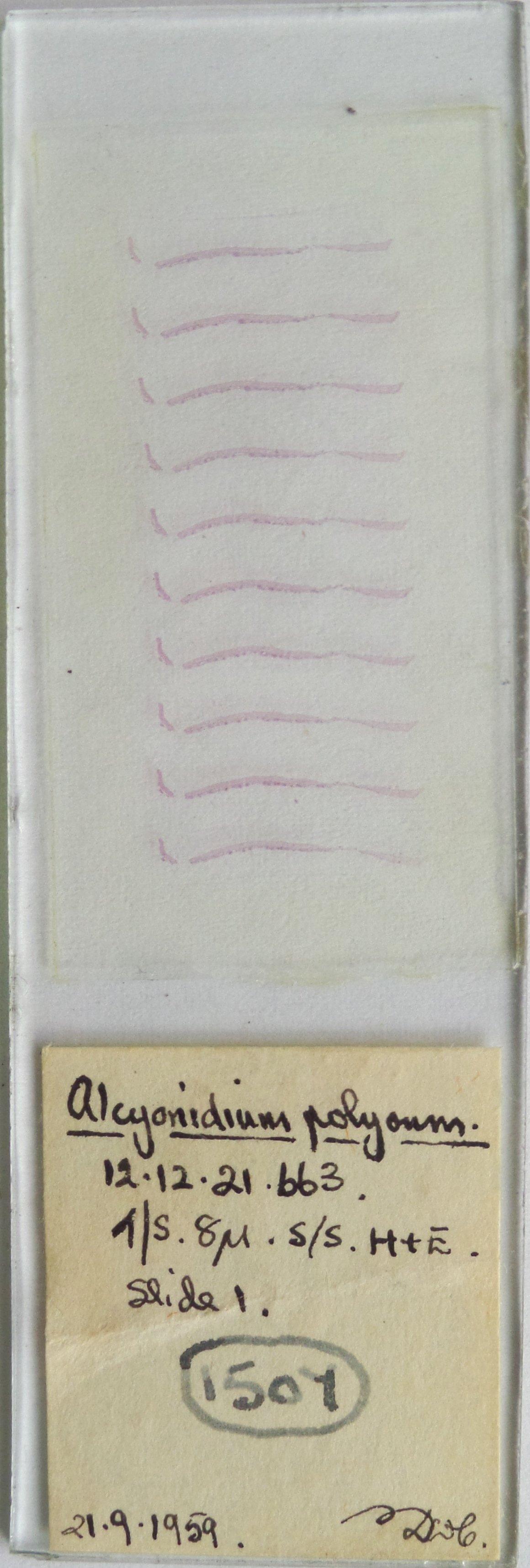WoRMS taxon details
Alcyonidium polyoum (Hassall, 1841)
153717 (urn:lsid:marinespecies.org:taxname:153717)
accepted
Species
Sarcochitum polyoum Hassall, 1841 · unaccepted (Basionym)
marine, brackish, fresh, terrestrial
(of Sarcochitum polyoum Hassall, 1841) Hassall, A. H. (1841). Description of two new genera of Irish zoophytes. . Annals and Magazine of Natural History, (1) 7: 483-486, available online at https://doi.org/10.1080/03745484109443626
page(s): 484 [details]
page(s): 484 [details]
Distribution Range covers both subprovinces of Acadian and Virginian.
Distribution Range covers both subprovinces of Acadian and Virginian. [details]
Bock, P. (2024). World List of Bryozoa. Alcyonidium polyoum (Hassall, 1841). Accessed through: World Register of Marine Species at: https://www.marinespecies.org/aphia.php?p=taxdetails&id=153717 on 2024-11-21
Date
action
by
![]() The webpage text is licensed under a Creative Commons Attribution 4.0 License
The webpage text is licensed under a Creative Commons Attribution 4.0 License
original description
(of Sarcochitum polyoum Hassall, 1841) Hassall, A. H. (1841). Description of two new genera of Irish zoophytes. . Annals and Magazine of Natural History, (1) 7: 483-486, available online at https://doi.org/10.1080/03745484109443626
page(s): 484 [details]
context source (ERMS) Gerovasileiou, V.; Rosso, A. (2016). Marine Bryozoa of Greece: an annotated checklist. <em>Biodiversity Data Journal.</em> 4: e10672., available online at https://doi.org/10.3897/bdj.4.e10672 [details]
basis of record Hayward, P.J. (1985). Ctenostome bryozoans: keys and notes for the identification of the species. <i>Synopses of the British fauna (new series)</i>, 33. E.J. Brill; W. Backhuys: London, UK. ISBN 90-04-07853-6. vii, 169 pp. (look up in IMIS) [details]
additional source Bromley; Bleakney. (1977). [details]
additional source Gosner, K. L. (1971). Guide to identification of marine and estuarine invertebrates: Cape Hatteras to the Bay of Fundy. <em>John Wiley & Sons, Inc., London.</em> 693 pp. [pdf copepod and branchiuran :445-455]. (look up in IMIS) [details] Available for editors [request]
[request]
additional source Linkletter, L. E. (1977). A checklist of marine fauna and flora of the Bay of Fundy. <em>Huntsman Marine Laboratory, St. Andrews, N.B.</em> 68: p. [details]
additional source Pollock, L.W. (1998). A practical guide to the marine animals of northeastern North America. Rutgers University Press. New Brunswick, New Jersey & London. 367 pp., available online at http://books.google.com/books?id=i1AmT31cuR4C [details]
additional source Ryland J.S. & Porter J.S. (2003). The identity of Alcyonidium gelatinosum (Linnaeus, 1761) (Bryozoa: Ctenostomatida). Journal of Natural History 37 (18): 2179-2189, available online at https://doi.org/10.1080/00222930210138917 [details] Available for editors [request]
[request]
additional source Winston, J. E. and F. J. Maturo Jr. 2009. Bryozoans (Ectoprocta) of the Gulf of Mexico, Pp. 1147–1164 in Felder, D.L. and D.K. Camp (eds.), Gulf of Mexico–Origins, Waters, and Biota. Biodiversity. Texas A&M Press, College Station, Texas. [details]
additional source Integrated Taxonomic Information System (ITIS). , available online at http://www.itis.gov [details]
page(s): 484 [details]
context source (ERMS) Gerovasileiou, V.; Rosso, A. (2016). Marine Bryozoa of Greece: an annotated checklist. <em>Biodiversity Data Journal.</em> 4: e10672., available online at https://doi.org/10.3897/bdj.4.e10672 [details]
basis of record Hayward, P.J. (1985). Ctenostome bryozoans: keys and notes for the identification of the species. <i>Synopses of the British fauna (new series)</i>, 33. E.J. Brill; W. Backhuys: London, UK. ISBN 90-04-07853-6. vii, 169 pp. (look up in IMIS) [details]
additional source Bromley; Bleakney. (1977). [details]
additional source Gosner, K. L. (1971). Guide to identification of marine and estuarine invertebrates: Cape Hatteras to the Bay of Fundy. <em>John Wiley & Sons, Inc., London.</em> 693 pp. [pdf copepod and branchiuran :445-455]. (look up in IMIS) [details] Available for editors
additional source Linkletter, L. E. (1977). A checklist of marine fauna and flora of the Bay of Fundy. <em>Huntsman Marine Laboratory, St. Andrews, N.B.</em> 68: p. [details]
additional source Pollock, L.W. (1998). A practical guide to the marine animals of northeastern North America. Rutgers University Press. New Brunswick, New Jersey & London. 367 pp., available online at http://books.google.com/books?id=i1AmT31cuR4C [details]
additional source Ryland J.S. & Porter J.S. (2003). The identity of Alcyonidium gelatinosum (Linnaeus, 1761) (Bryozoa: Ctenostomatida). Journal of Natural History 37 (18): 2179-2189, available online at https://doi.org/10.1080/00222930210138917 [details] Available for editors
additional source Winston, J. E. and F. J. Maturo Jr. 2009. Bryozoans (Ectoprocta) of the Gulf of Mexico, Pp. 1147–1164 in Felder, D.L. and D.K. Camp (eds.), Gulf of Mexico–Origins, Waters, and Biota. Biodiversity. Texas A&M Press, College Station, Texas. [details]
additional source Integrated Taxonomic Information System (ITIS). , available online at http://www.itis.gov [details]
 Present
Present  Present in aphia/obis/gbif/idigbio
Present in aphia/obis/gbif/idigbio  Inaccurate
Inaccurate  Introduced: alien
Introduced: alien  Containing type locality
Containing type locality
From regional or thematic species database
Diet Small microorganisms, including diatoms and other unicellular algae. [details]Unreviewed
Distribution Range covers both subprovinces of Acadian and Virginian. [details]Habitat sessile, colonial on hard substratum epifauna in the marine environment [details]
Predators grazing organisms such as sea urchins and fish; also subject to competition and overgrowth from sponges, algae, and tunicates [details]
Reproduction sexual and asexual; bryozoan colonies consist of replicated series of zooids, each budded asexually from a predecessor. The founding zooid metamorphoses from the sexually produced larva. Hermaphroditic. [details]
To Barcode of Life
To Biodiversity Heritage Library (49 publications)
To European Nucleotide Archive, ENA (Alcyonidium polyoum)
To GenBank (4 nucleotides; 1 proteins) (from synonym Sarcochitum polyoum Hassall, 1841)
To GenBank (4 nucleotides; 1 proteins)
To NHMUK collection (Alcyonidium polyoum (Hassall, 1841); NHMUK:ecatalogue:697354)
To USNM Invertebrate Zoology Bryozoa Collection (13 records)
To ITIS
To Biodiversity Heritage Library (49 publications)
To European Nucleotide Archive, ENA (Alcyonidium polyoum)
To GenBank (4 nucleotides; 1 proteins) (from synonym Sarcochitum polyoum Hassall, 1841)
To GenBank (4 nucleotides; 1 proteins)
To NHMUK collection (Alcyonidium polyoum (Hassall, 1841); NHMUK:ecatalogue:697354)
To USNM Invertebrate Zoology Bryozoa Collection (13 records)
To ITIS

